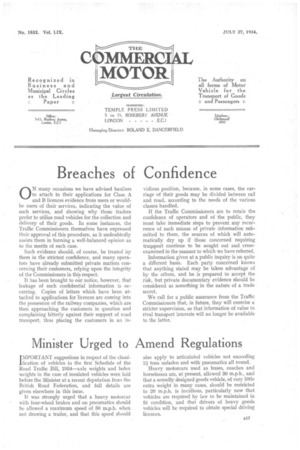Minister Urged to Amend Regulations
Page 35

Page 36

If you've noticed an error in this article please click here to report it so we can fix it.
IMPORTANT suggestions in respect of the classiification of vehicles in the first Schedule of the Road Traffic Bill, 1934—axle weights and laden weights in the case of insulated vehicles were laid before the Minister at a recent deputation from the British Road Federation, and full details are given elsewhere in this issue.
It was strongly urged that a heavy motorcar with four-wheel brakes and on pneumatics should be allowed a maximum speed of 30 m.p.h. when not drawing a trailer, and that this speed should also apply to articulated vehicles not exceeding 2Atons unladen and with pneumatics all round.
Heavy motorcars used as buses, coaches and horseboxes are, at present, allowed 30 m.p.h., and that a soundly designed goods vehicle, of very little extra weight in many cases, should be restricted to 20 m.p.h. is invidious, particularly now that vehicles are required by law to be maintained in fit condition, and that drivers of heavy goods vehicles will be required to obtain special driving licences. We have, on many occasions, put forward a plea that the speeds of the various classes of commercial vehicle on the road should, so far as possible, be co-ordinated, thus avoiding congestion and the danger caused by the continual overtaking of vehicles which the present variation of speeds necessitates.
The light articulated vehicle of good design is quite apart from the vehicle and trailer in respect of its manoeuvrability and safety at speed, and such a light machine should certainly be permitted to travel at the higher limit suggested.
The matter of axle weights has long been a bone of contention. The distribution of the load on the normal-control vehicle is approximately 25 per cent. on the front axle and 75 per cent. on the rear ; thus, with a four-wheeler to carry 12 tons the front-axle weight should be approximately 3 tons and the back-axle weight 9 tons, and the present limit of 8 tons debars many vehicles from carrying their legal load in a safe manner.
The insulated body for the transport of meat and other perishable goods is an increasingly important branch of the road-transport industry, but such bodies must usually weigh considerably more than the standard types, so that, in the ordinary course, the larger models cannot be fully loaded, and the insulation efficiency is therefore considerably reduced. It is suggested that for this specialized type the regulation should be amended to permit an increase in the laden weight above that applicable to vehicles not carrying the same type of body sufficient to compensate for the additional load caused by the insulation.
Estimating Coach Traffic
ONE of the greatest difficulties of the operation of coach excursions and tours is to gauge in advance the need for a service. Mr. J. Farndale, chairman of the Yorkshire Traffic Commissioners, recently issued a warning against the practice of advertising an excursion or tour subject to the issue of a licence by the Commissioners, and obtaining tentative bookings, on the understanding that money would be returned if the licence were not granted.
Although, from the business point of view, this method may be unsound, we consider that the Commissioners would be misdirected in ignoring evidence of the public demand thus secured. It is a practice that, apparently, the Commissioners have no power to stop, and it provides a fairly accurate guide to the response of the public to new excursion and tour facilities.
The necessity of resorting to such methods might, however, be avoided if experimental shortperiod licences were granted, in suitable cases, to enable operators to test the public need for services of excursions and tours. In this way, coach proprietors would be provided with the opportunity of submitting concrete evidence of the desirability of additional road-transport facilities, whilst the public would be afforded a right of choice that it is, at present, denied.
There is, of course, not the same need for such experimental measures in connection with regular services, which cater for steady traffic.




































































































